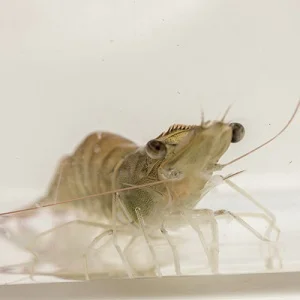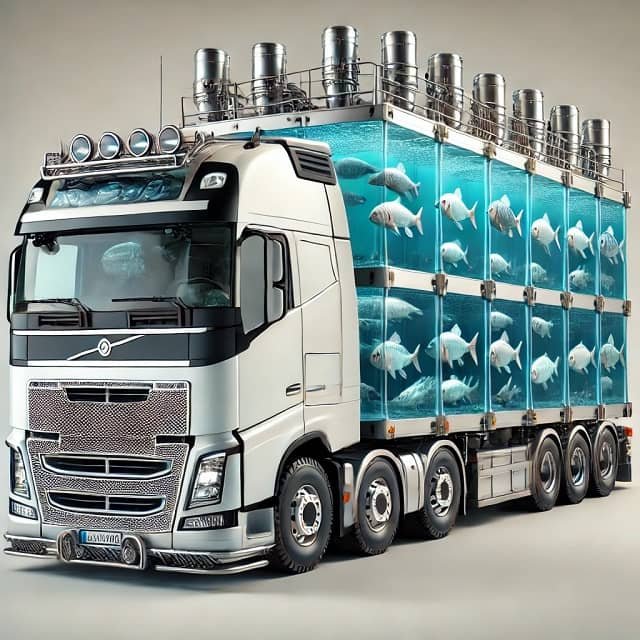
Maintaining the quality of live shrimp throughout the supply chain, from farm to consumer, is a crucial challenge for the aquaculture sector. Various stages such as harvesting, transportation, resting, and marketing can cause stress in the animals, affecting their survival, muscle quality, and gut microbiota.
A recent scientific study, published by researchers from Ningbo University, has thoroughly investigated these factors, providing valuable information for optimizing practices in the supply chain. This article breaks down the key findings of this research, focusing exclusively on the information contained in the study.
The shrimp’s journey: an analysis of the live supply chain
- 1 The shrimp’s journey: an analysis of the live supply chain
- 2 How were the quality and microbiota of the shrimp evaluated?
- 3 Impact of transport and rest: critical moments for the shrimp
- 4 Gut microbiota: a reflection of shrimp quality
- 5 Critical control points and optimization strategies
- 6 Conclusion
- 7 Entradas relacionadas:
To understand how the supply chain affects Penaeus vannamei, researchers evaluated several critical phases: the post-harvest state (directly from the pond), post-transport (after a 30-minute transfer), post-rest (after a 3-hour recovery period), and a simulated sales phase of up to 48 hours under two temperature conditions: ambient temperature (AT, 29∘C±0.3∘C) and low temperature (LT, 23∘C±0.3∘C). This simulation allowed for the observation of changes in muscle quality and gut microbiota of the shrimp under controlled conditions.
How were the quality and microbiota of the shrimp evaluated?
The research employed a comprehensive approach to measure the impact of the supply chain. Scientists analyzed the cumulative survival rate of the shrimp at each stage. To determine muscle quality, they measured key physicochemical parameters such as:
- Color and transparency: Using a colorimeter to record luminosity (L*) values, color coordinates a* (red-green) and b* (yellow-blue), and the total color difference (ΔE∗).
- Texture: Texture profile analysis (TPA) was performed to measure the hardness, gumminess, chewiness, and springiness of the muscle.
- pH and lactate content: Indicators of metabolic stress and post-mortem degradation.
- Thiobarbituric acid reactive substances (TBARS): An indicator of lipid oxidation and flavor deterioration. In parallel, the researchers conducted a detailed analysis of the gut microbiota by sequencing 16S ribosomal RNA to identify the composition and diversity of bacterial communities and predict their metabolic functions in the different stages and conditions.
Impact of transport and rest: critical moments for the shrimp
The stress of the journey
The study, published in the journal MDPI, revealed that the transport stage is particularly stressful for shrimp. They observed the highest mortality (12%) after transport, which underscores the severe impact of this phase. The muscle pH significantly decreased from 7.19±0.02 (post-harvest) to 6.67±0.02 (post-transport), while lactate content soared from 8.41±1.25μmol/g to 31.48±1.02μmol/g.
The changes reported in the study are indicative of accentuated anaerobic metabolism due to stress. The gut microbiota also underwent alterations, with an increase in the relative abundance of Proteobacteria (from 21.63% to 32.53%) and Actinobacteria (from 18.81% to 33.44%), and a decrease in Firmicutes (from 28.90% to 7.43%) and Bacteroidetes (from 4.08% to 0.41%).
The importance of a rest
After transport, a 3-hour rest period proved beneficial. Although the survival rate continued to decline slightly to 82.48%±0.33%, signs of recovery were observed. Muscle pH increased to 6.92±0.02 and lactate content decreased drastically.
The gut microbiota also showed changes: the abundance of Firmicutes increased considerably (to 52.61%), while Proteobacteria and Actinobacteria decreased. These findings suggest that a rest period can help mitigate transport stress and promote physiological and microbiological rebalancing in shrimp.
Stay Always Informed
Join our communities to instantly receive the most important news, reports, and analysis from the aquaculture industry.
Water temperature during sale: a key factor
During the simulated sales phase, the holding temperature was a determining factor for the survival and quality of the shrimp.
Benefits of cold
The group kept at low temperature (LT, 23∘C) consistently showed better results compared to the group at ambient temperature (AT, 29∘C).
- Higher survival: At the end of the 48-hour simulation, the LT group had an 8% higher survival rate than the AT group (75.43% vs 67.81%).
- Better muscle quality:
- Texture: Muscle hardness in the LT group was significantly higher (34.9% more at the end of 48h) compared to the AT group, where hardness, gumminess, and chewiness tended to decrease.
- Color: The LT group generally exhibited higher luminosity (L*) and b* values, and a lower total color difference (ΔE∗), indicating better color stability and greater muscle transparency, especially at 24 and 48 hours.
- pH: The pH in the LT group tended to be more stable and even increased slightly at the end of the period, while in the AT group it showed a slight decrease.
- More stable gut microbiota:
- The LT group showed an increase in the relative abundance of Bacteroidetes (from 3.63% to 7.39% between 0 and 48h), a bacterial phylum often associated with a healthy intestinal environment. In contrast, in the AT group, Bacteroidetes decreased.
- The Firmicutes:Bacteroidetes (F:B) ratio in the LT group decreased from 13.29 to 7.28, while in the AT group it increased drastically from 30.44 to 115.22. A lower F:B ratio has been associated in some contexts with healthier states. These results highlight the effectiveness of keeping shrimp at a lower temperature during the sales phase to preserve their quality and extend their shelf life.
Gut microbiota: a reflection of shrimp quality
The study delved into how the gut microbiota of Penaeus vannamei changes throughout the supply chain and correlates with muscle quality.
Scientists reported significant changes in microbiota composition at different stages. For example, transport induced an increase in diversity that later decreased after rest. During the simulated sale, diversity tended to increase in both temperature groups, being significantly higher in the LT group at 48 hours.
Of particular interest was the identification of two bacterial orders, Xanthomonadales (from the Proteobacteria phylum) and Oscillospirales (from the Firmicutes phylum), as potential biomarkers of good shrimp quality. In the LT group, the abundance of these bacteria correlated positively with higher survival rates, better muscle texture (hardness), and greater brightness (L*). These findings suggest that these bacteria could play a role in maintaining shrimp quality under cold stress conditions or that their presence is indicative of better adaptation and physiological state.
The gut microbiota influences host health through various pathways, including nutrient metabolism, immune system modulation, and protection against pathogens. Although this study did not explore direct mechanisms, the observed changes in microbiota and their predicted functions (through PICRUSt2 analysis) suggest a dynamic connection between the gut and muscle quality. For example, transport altered metabolic pathways related to energy, amino acid synthesis, and antioxidant stress. Rest, on the other hand, seemed to activate pathways that could mitigate transport-induced damage.
Critical control points and optimization strategies
Based on the observed changes in survival and quality parameters, the study identified three potential critical control points (CCPs) in the live shrimp supply chain:
- The transport stage.
- The 24 hours of the sales phase.
- The 40 hours of the sales phase (from which point some color parameters began to deteriorate more noticeably). These CCPs are moments where interventions could have the greatest impact on the final product quality. The main recommendations derived from this study to optimize the supply chain are:
- Standardize a post-transport rest procedure: This can alleviate stress and improve shrimp recovery, especially in longer transports.
- Maintain low temperatures (approximately 23∘C) during the sales phase: This practice was shown to significantly improve survival and muscle quality parameters, in addition to stabilizing the gut microbiota.
Conclusion
This study underscores that the live shrimp Penaeus vannamei supply chain presents significant challenges, with transport being the most critical stage in terms of initial mortality. However, strategies such as an adequate rest period and, crucially, temperature control during marketing (maintaining around 23∘C), can drastically improve survival and preserve muscle quality.
Furthermore, the research highlights the crucial role of the gut microbiota as a sensitive indicator of shrimp condition and a possible modulating factor of its quality. The identification of Xanthomonadales and Oscillospirales as potential biomarkers opens new avenues for monitoring and improving management strategies in aquaculture and in the post-harvest supply chain.
For shrimp producers and distributors, these findings offer a scientific basis for implementing practices that not only reduce losses but also ensure the delivery of a higher quality product to the end consumer, thereby strengthening the sector’s competitiveness. Future research could focus on validating these results in longer-distance transports and further exploring host-microbiota interactions to develop even more refined quality control strategies.
The study was funded by the National Key Research and Development Programs of China, the National Natural Science Foundation of China, the Natural Science Foundation of Zhejiang Province for Distinguished Young Scholars, and the Projects of the Bureau of Science and Technology of Ningbo City.
Reference (open access):
Zhang, P., Jiang, Z., Zhang, Y., Leng, L., Yin, Z., He, W., Zeng, X., & Pan, D. (2025). Changes in Muscle Quality and Gut Microbiota of Whiteleg Shrimp (Penaeus vannamei) Within a Live Supply Chain. Animals, 15(10), 1431. https://doi.org/10.3390/ani15101431
Editor at the digital magazine AquaHoy. He holds a degree in Aquaculture Biology from the National University of Santa (UNS) and a Master’s degree in Science and Innovation Management from the Polytechnic University of Valencia, with postgraduate diplomas in Business Innovation and Innovation Management. He possesses extensive experience in the aquaculture and fisheries sector, having led the Fisheries Innovation Unit of the National Program for Innovation in Fisheries and Aquaculture (PNIPA). He has served as a senior consultant in technology watch, an innovation project formulator and advisor, and a lecturer at UNS. He is a member of the Peruvian College of Biologists and was recognized by the World Aquaculture Society (WAS) in 2016 for his contribution to aquaculture.




